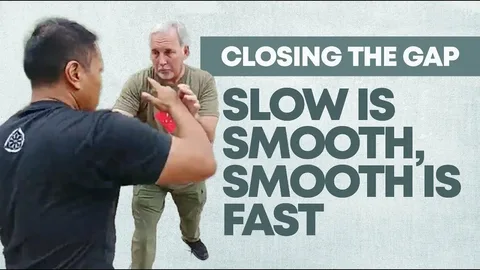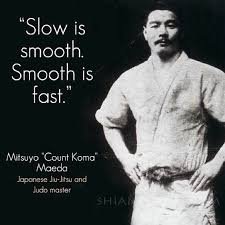How Going Slow Can Actually Speed You Up: A Deep Dive into ‘slow is smooth and smooth is fast’
kifayatullahmohmand997@gmail.com
Title: How Going Slow Can Speed You Up: A Deep Dive into ‘slow is smooth and smooth is fast’
In a world that values speed and instant results, the phrase “Slow is smooth, smooth is fast” may seem counterintuitive. However, this concept, originating from military training, has profound applications in many areas of life. The idea behind this phrase is simple: by slowing down and focusing on doing things right, we can accomplish tasks more efficiently and with better outcomes. This article will explore what this concept means, why it works, and how it can transform how you approach everything from work to personal development.
Table of Contents
Understanding the Meaning: “Slow is Smooth, Smooth is Fast.”
At first glance, “slow is smooth, smooth is fast” seems like a paradox. How can slowing down make you faster? This phrase originated in high-pressure military and tactical settings, where precision and accuracy are crucial, and making mistakes can be costly. The logic is that when you focus on moving slowly and smoothly, you can reduce errors, stay calm, and build muscle memory. Over time, this smooth, intentional approach helps you move faster because you’re still trying to correct mistakes or recover from rushed decisions.
Imagine you’re learning to play the guitar. If you rush to play a song quickly without knowing the correct fingering and timing, you’ll likely need to work on mistakes. But if you take it slow, carefully learning each note, you’ll play more smoothly and, eventually, pick up the speed.
Why “Slow is Smooth, Smooth is Fast” Works

- Reduces Errors and the Need for Corrections
- When we rush through tasks, we often make mistakes that require us to stop, correct, and start again. This slows us down in the long run.
- By focusing on smooth, deliberate actions, we can reduce mistakes. Fewer mistakes mean less time spent redoing work, leading to faster overall progress.
- Builds Muscle Memory and Consistency
- Repetition with focus helps build muscle memory, whether it’s a physical task like sports or a mental task like coding.
- When we do something slowly and correctly, our brain and body remember the correct form, eventually allowing us to perform the task quickly and accurately.
- Promotes Mindfulness and Focus
- Slowing down requires focus and mindfulness, which can improve the quality of our work.
- Concentrating on each step makes us more engaged, aware, and accurate in our work. This makes us more productive and helps us reach our goals faster.
- Reduces Stress and Prevents Burnout
- Rushing can lead to stress and burnout, which slow us down in the long run.
- Taking a slower, smoother approach reduces the pressure and allows us to be consistent without feeling overwhelmed. This approach is more sustainable, helping us maintain momentum over the long term.
Applications of “Slow is Smooth, Smooth is Fast”
- Skill Development
Patience is essential whether learning a new language, mastering an instrument, or picking up a new sport. There’s often pressure to become proficient quickly in skill development, but rushing through the basics can lead to bad habits. Here’s how a slower, more deliberate approach can help:
- Focus on Form: Correct form is critical in activities like playing an instrument, lifting weights, or painting. Taking time to learn the proper form early on creates a strong foundation.
- Practice Mindfully: Rather than quickly moving through repetitive drills, take the time to focus on each repetition. Practicing this way builds “smoothness,” or accuracy, eventually allowing for more incredible speed and skill.
- Productivity and Work Efficiency
The concept of “slow is smooth, smooth is fast” can also revolutionize our work. Rather than racing through tasks, taking a slower, more intentional approach helps improve the quality and efficiency of our work.
- Break Down Tasks: Rather than rushing through a big project, break it down into smaller, manageable steps. Focus on completing each step smoothly before moving on. This approach reduces the chances of mistakes and redoing work, saving time in the long run.
- Prioritize Quality Over Quantity: Instead of multitasking or quickly finishing tasks, focus on doing each task well. By giving full attention to one task at a time, you’ll complete it more effectively, leading to faster, higher-quality work.
- Physical Training and Fitness
Fitness is where “slow is smooth, smooth is fast” makes a huge impact. Many people rush through workouts, but a slower approach can often be more effective:
- Proper Form in Exercises: Proper form is essential when lifting weights or performing bodyweight exercises to avoid injuries. By moving slowly, you can concentrate on each movement, ensuring correct form, which helps build strength safely and sustainably.
- Progression and Consistency: Fitness goals take time. Building strength or improving endurance takes time. Focusing on gradual, consistent improvement over time helps achieve long-lasting fitness without risking burnout or injury.
- Personal Development and Self-Improvement
Growth Growth often feels slow in self-improvement in self-improvement, and the urge to make fast changes is high. However, rushing usually leads to frustration. A smoother, slower approach, focused on small, consistent actions, can lead to profound change:
- Set Small, Achievable Goals: Instead of making drastic changes overnight, set small, attainable goals and work on them steadily. This smoother approach creates sustainable habits that last longer.
- Practice Patience and Reflection: Give yourself time to reflect on your progress and adapt your approach. This reflection helps you stay on course and makes improvement more effortless and manageable.
How to Practice “Slow is Smooth, Smooth is Fast” in Everyday Life
1. Be Present with Each Task
- Whenever you start a new task, consciously remind yourself to slow down and focus on the task at hand.
- Engage fully and pay attention to each step. This mindfulness will help you improve your focus and performance over time.
2. Set Realistic Expectations
- Understand that progress takes time, and setting too high expectations can lead to frustration and rushing.
- Aim to make consistent, steady progress rather than expecting overnight results. Remember, building momentum slowly allows for a stronger foundation.
3. Break Tasks into Small Steps
- Breaking a task into smaller parts can make it easier to approach slowly and smoothly.
- Focus on completing each small step well before moving on, which reduces the need to backtrack or fix mistakes.
4. Embrace the Process Over the Outcome
- Rather than fixating on the outcome, focus on enjoying and improving the process. When you value the steps that get you there, you’re less likely to rush and more likely to perform well.
5. Reflect and Adjust
- Periodically review your progress to ensure you’re moving smoothly. If something feels rushed, take a step back and adjust your approach.
- This habit of reflection helps you maintain smooth, steady progress without sacrificing speed.
The Benefits of Going Slow to Move Fast
Embracing “slow is smooth, smooth is fast” may take some adjustment, mainly if you’re used to rushing through tasks. But here are some long-term benefits that make it worthwhile:
- Higher Quality Work: Slower, smoother work is often of better quality. This approach lets you focus entirely, catch errors early, and improve accuracy.
- Reduced Stress and Burnout: Rushing through tasks adds stress, which can lead to burnout over time. A slower approach allows for a healthier pace, reducing stress and increasing satisfaction.
- Increased Confidence and Mastery: As you build consistency and precision, you’ll naturally gain confidence in your abilities. Over time, this confidence translates to faster, more efficient performance.
- Greater Sustainability: Whether it’s in work, hobbies, or self-improvement, the “slow and smooth” approach is more sustainable. It allows you to make steady progress without burning out, keeping you on the path to success.
Conclusion
The phrase “slow is smooth, smooth is fast” teaches us a valuable lesson: sometimes, slowing down is the fastest way to make lasting progress. By focusing on quality, consistency, and patience, we can accomplish our goals more efficiently and with better results. Whether at work, in the gym, or personal growth, embracing a slower, smoother approach can lead to faster, more meaningful progress.
F.A.Q.s
Q: Why does “slow is smooth, smooth is fast” work so well?
Taking things slowly and smoothly reduces mistakes, promotes mindfulness, and builds muscle memory, leading to faster and more effective outcomes.
Q: Can I apply “slow is smooth, smooth is fast” to productivity at work?
Yes! This approach can improve work efficiency by helping you focus on quality, reduce errors, and quickly complete tasks with fewer interruptions.
Q: Is this approach suitable for physical training?
Absolutely. Slow, smooth movements in fitness ensure proper form, reduce injury risk, and build a strong foundation for faster, safer workouts over time.
Q: How can I remind myself to slow down when rushed?
To manage the urge to rush, practice mindfulness techniques, break tasks into smaller steps, and set realistic goals.




Write a Comment